Oklahoma provides abundant habitat for many types of sparrows, including its prairies and grasslands and its millions of acres of farmland.
From birds whose range barely enters Oklahoma in the western tip of the Panhandle to the Henslow’s sparrow, typically seen in only the eastern counties of Washington and Osage, here are 30 sparrow species with ranges that extend into Oklahoma.
Unless otherwise noted, all measurements are courtesy of the Cornell Lab of Ornithology’s All About Birds, a great website for bird watchers to identify and learn more about the birds in North America.
House Sparrow
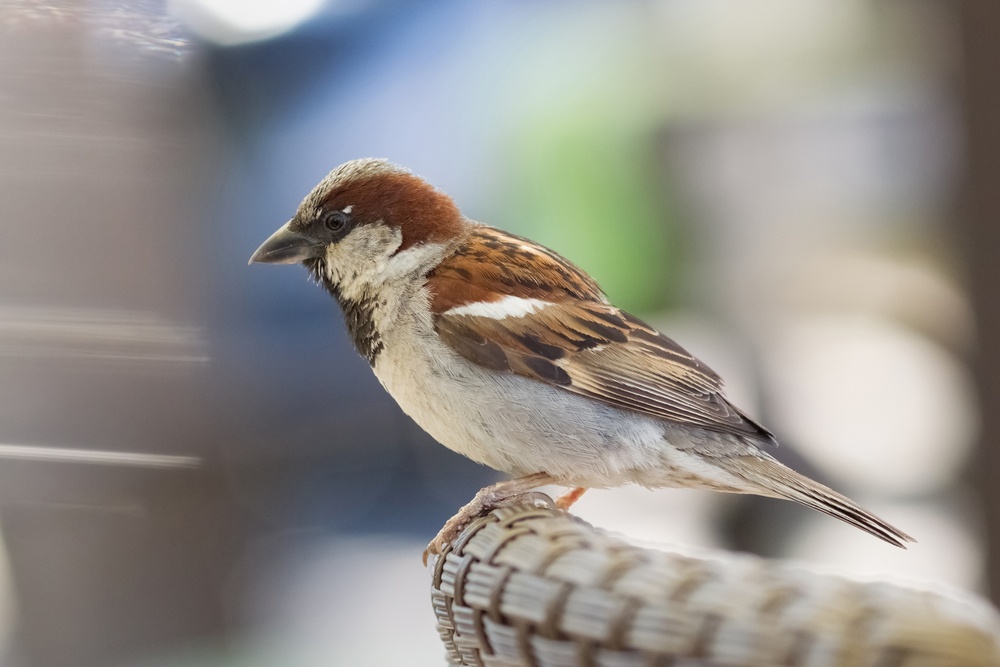
- Passer domesticus
- Length: 5.9-6.7 inches
- Weight: 0.9-1.1 ounces
- Wingspan: 7.5-9.8 inches
Whether you’re an avid birder with a 500-bird life list or a casual enjoyer of the birds you see on your daily walk, you’re probably acquainted with the house sparrow, one of North America’s most famous invasives.
Since their introduction to the continent, these sparrows have popped up just about everywhere, including in cities and suburbs, where they’re common at backyard bird feeders and on sidewalks.
They’re unpopular, having gained a reputation as birds that compete directly for resources like food and nesting spots with native birds. In particular, they are cavity nesters that may destroy the nest of a native bird such as a bluebird to lay their own eggs.
Not particularly closely related to most sparrows on the list, male house sparrows are portly birds with gray bellies and a black bib connected to a thick black bill and to the eye, where it meets a chestnut-brown patch covering the side of the head and nape.
Females have the same thick bill. Their undersides are unstreaked, with brown markings on the top and wings.
American Tree Sparrow
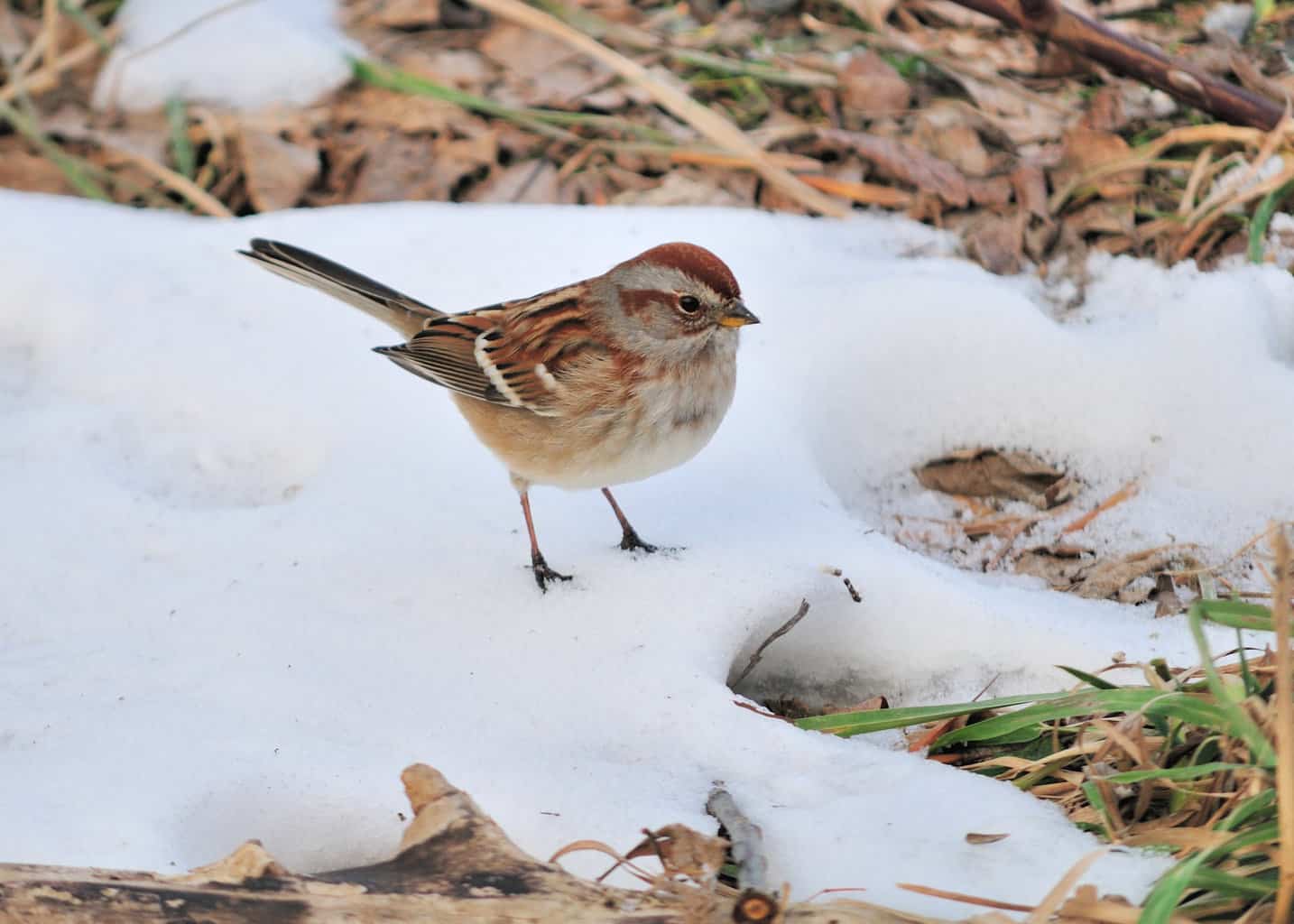
- Spizelloides arborea
- Length: 5.5 inches
- Weight: 0.5-1.0 ounces
- Wingspan: 9.4 inches
If you see a sparrow in a tree somewhere in America for most of the year, chances are it’s not an American tree sparrow despite what its name would lead you to believe.
American tree sparrows nest in the northern reaches of Canada and Alaska before leaving the Great White North each fall to spend their winters in the Lower 48. According to All About Birds, European settlers named the tree sparrow because it reminded them of Eurasian tree sparrows back home, even though they don’t look very similar and American tree sparrows are ground birds.
Look for these sparrows in fields, marshy areas, and backyards, where they will sometimes visit feeders.
Males and females both have rusty brown caps with a bill that splits in color down the middle, dark on top and yellow on the bottom. A black mark in the center of the chest and other rusty markings, such as through the eye and near the base of the wing, also stand out.
They’re less common as you move south through Oklahoma, according to the Oklahoma Department of Wildlife Conservation.
Chipping Sparrow
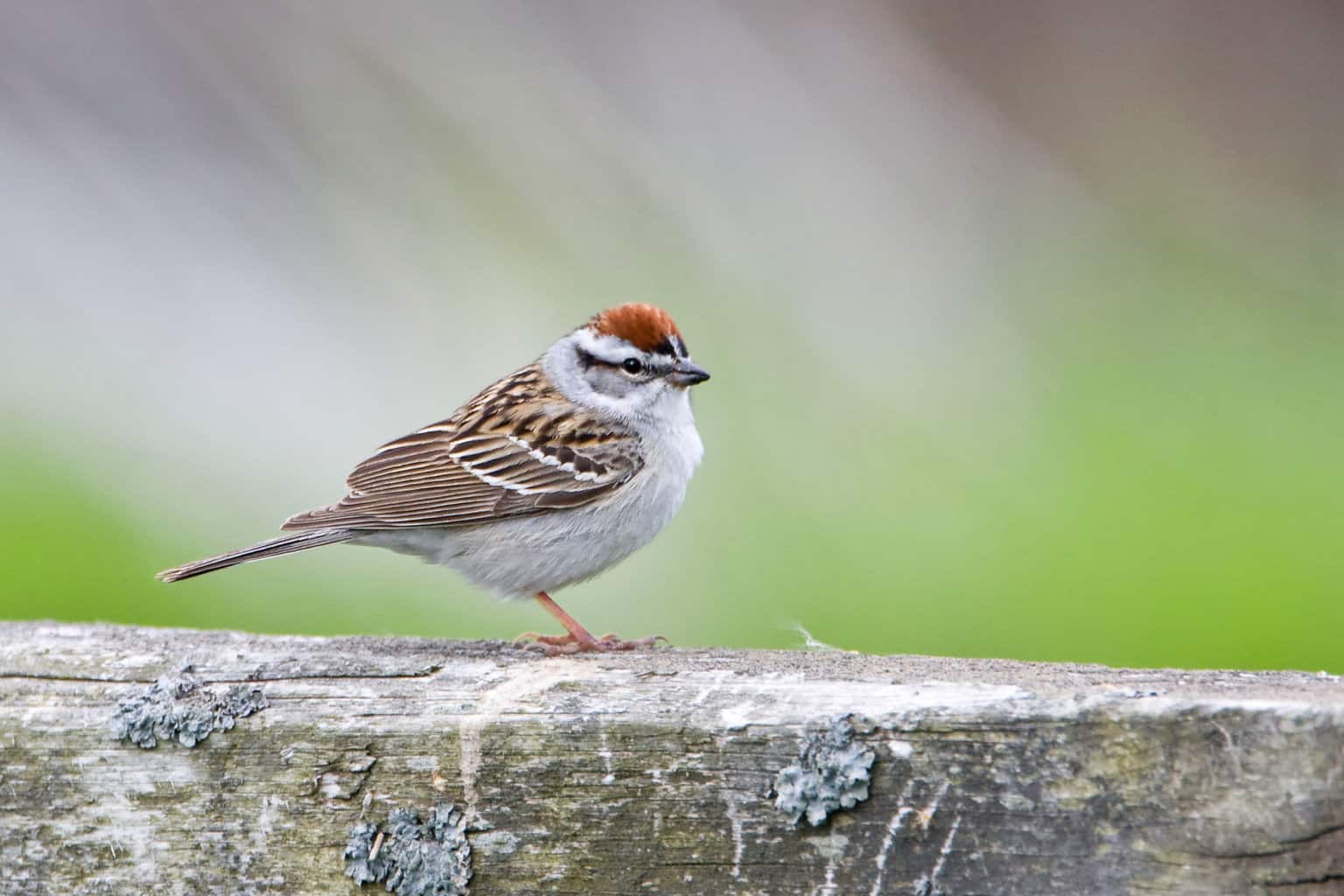
- Spizella passerina
- Length: 4.7-5.9 inches
- Weight: 0.4-0.6 ounces
- Wingspan: 8.3 inches
Another bird with a standout rusty cap is the chipping sparrow, which you can tell from the tree sparrow by its black eyeline, lack of a black spot in the center of the chest, and singularly colored bill.
Chipping sparrows have one of the widest breeding ranges of any North American sparrow, from Hudson Bay down to Mexico and the Gulf Coast. That range also includes most of Oklahoma, where they can be found in parks, backyards, and any area with a handful of shrubs or trees.
Listen for their singular chips throughout the year and their trill song each spring.
Field Sparrow
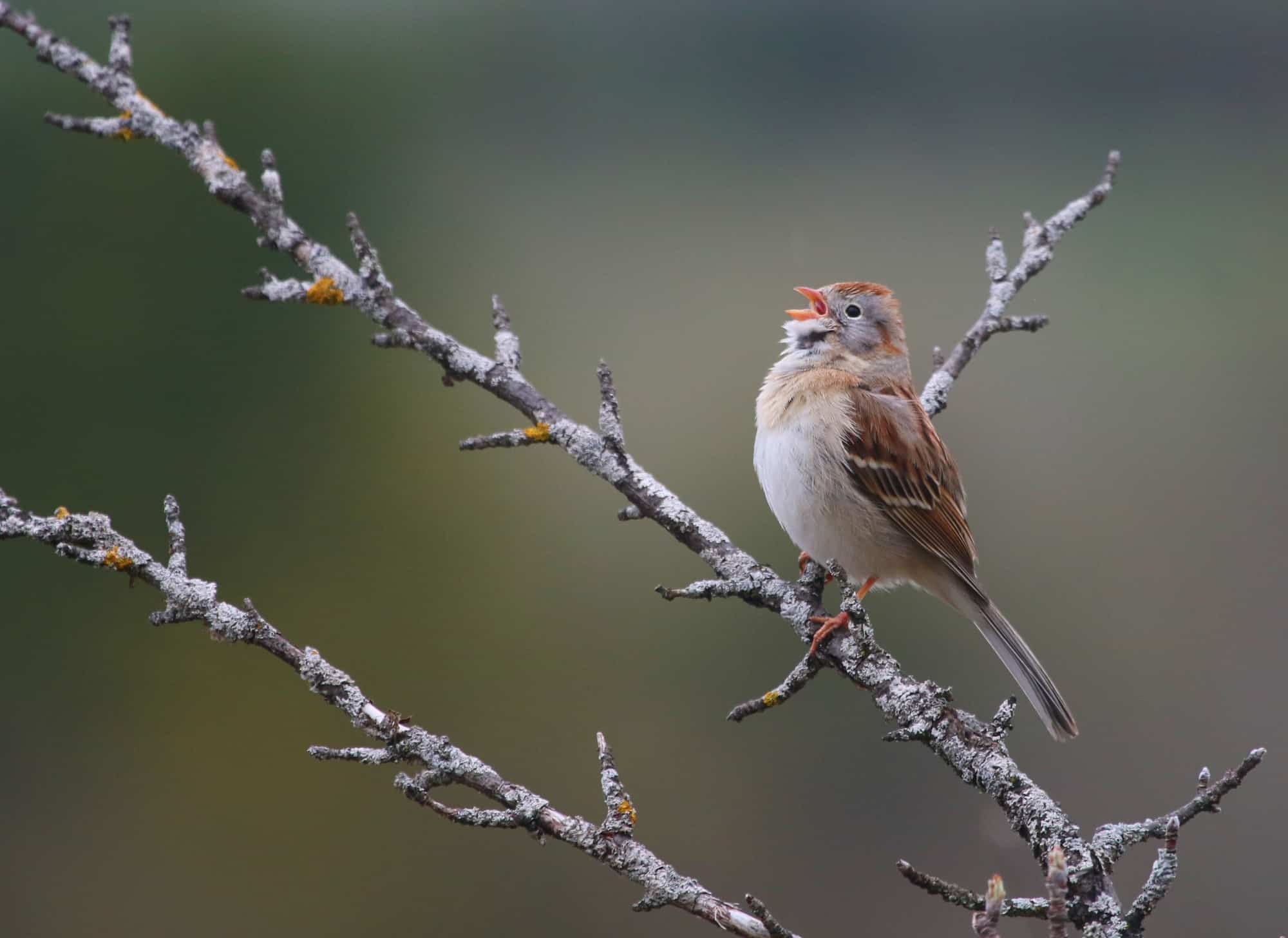
- Spizella pusilla
- Length: 4.7-5.9 inches
- Weight: 0.4-0.5 ounces
- Wingspan: 7.9 inches
Field sparrows also have rusty caps atop their small heads, though they’re not quite as dark as those of the chipping sparrow. They also have a light, similarly colored eyeline just behind the eye, as well as a light pink bill.
Year-round residents in most of the Sooner State, field sparrows are more conspicuous in the spring when their songs fill the sky.
Only the panhandle is outside this sparrow’s year-round range, according to the Oklahoma Department of Wildlife Conservation, which suggests looking for these common little birds in open woodlands, savannahs, and prairies.
Swamp Sparrow

- Melospiza georgiana
- Length: 4.7-5.9 inches
- Weight: 0.5-0.8 ounces
- Wingspan: 7.1-7.5 inches
So far on our list, we’ve had the inaccurately named tree sparrow and the accurately named field sparrow. Another bird whose name fits the species is the swamp sparrow, common in northeastern and midwestern marshes, swamps, and bogs.
Their breeding range also extends up through western Canada and they winter throughout the eastern Sun Belt in Mexico. This puts much of Oklahoma in its migration path and the eastern half of the state within its potential winter range.
They have heads streaked in a relatively dark brown with a bicolored bill (yellowish on the bottom, darker on the top).
Lincoln’s Sparrow

- Melospiza lincolnii
- Length: 5.1-5.9 inches
- Weight: 0.6-0.7 ounces
- Wingspan: 7.5-8.7 inches
Lincoln’s sparrows have dark streaks on the head and face as well, but they are much streakier throughout the chest and sides than the swamp sparrow, which features an unstreaked white and brown underside.
Like swamp sparrows, Lincoln’s sparrows are most likely to be spotted in Oklahoma during the winter before heading north or west into the Rockies in the fall.
From fall through spring, look for them in thick fields and overgrown meadows and pastures.
Song Sparrow

- Melospiza melodia
- Length: 4.7-6.7 inches
- Weight: 0.4-1.9 ounces
- Wingspan: 7.1-9.4 ounces
Another streaky brown bird found in Oklahoma during the winter is the song sparrow.
Sometimes a visitor of backyard feeders, song sparrows can be found along Oklahoma’s roadsides, in cattail marshes, and in other wet areas, according to the Oklahoma DWC.
Song sparrows have white bellies and thick streaks down the chest, back, and face, including one mustache mark and horizontal stripe through the eyeline.
Those stripes may be a darker brown or lighter like the next bird on our list.
Fox Sparrow

- Passerella iliaca
- Length: 5.9-7.5 inches
- Weight: 0.9-1.6 ounces
- Wingspan: 10.5-11.4 inches
Fox sparrows sport splotchy markings of red or brown down to the belly, mixed with gray on the face and back of the neck. They’re larger than most other sparrows on the list and may look more like a thrush than a sparrow.
Fox sparrows have significant regional differences across North America. The red fox sparrow is most common across the continent, with other regional styles in the Rocky Mountains, California, and along the Pacific coast.
They’re primarily winter visitors of the Sooner state, though some birds in the state will continue to head further south or east on their migration path.
They require enough cover such as those found in forests. They may be seen picking around on the ground under feeders, though that’s uncommon outside of sustained icy and snowy periods, the Oklahoma DWC states.
Savannah Sparrow

- Passerculus sandwichensis
- Length: 4.3-5.9 inches
- Weight: 0.5-1.0 ounces
- Wingspan: 7.9-8.7 inches
Savannah sparrows are best identified by a little yellow mark just above and in front of the eye. It takes up a spot in between sections of brown and white that cover the face.
They have small bills and brown streaks that run vertically down the chest to the belly.
Like some of the other sparrows so far on this list, Savannah sparrows are winter birds throughout Oklahoma. Grasslands, marshes, and other relatively open areas are good places to look for Savannah sparrows.
Though this bird’s name may feel fitting because of the similarity to their habitat preference for grassy areas called savannas, they’re named for a specimen collected in the city of Savannah, Georgia, according to All About Birds.
Vesper Sparrow
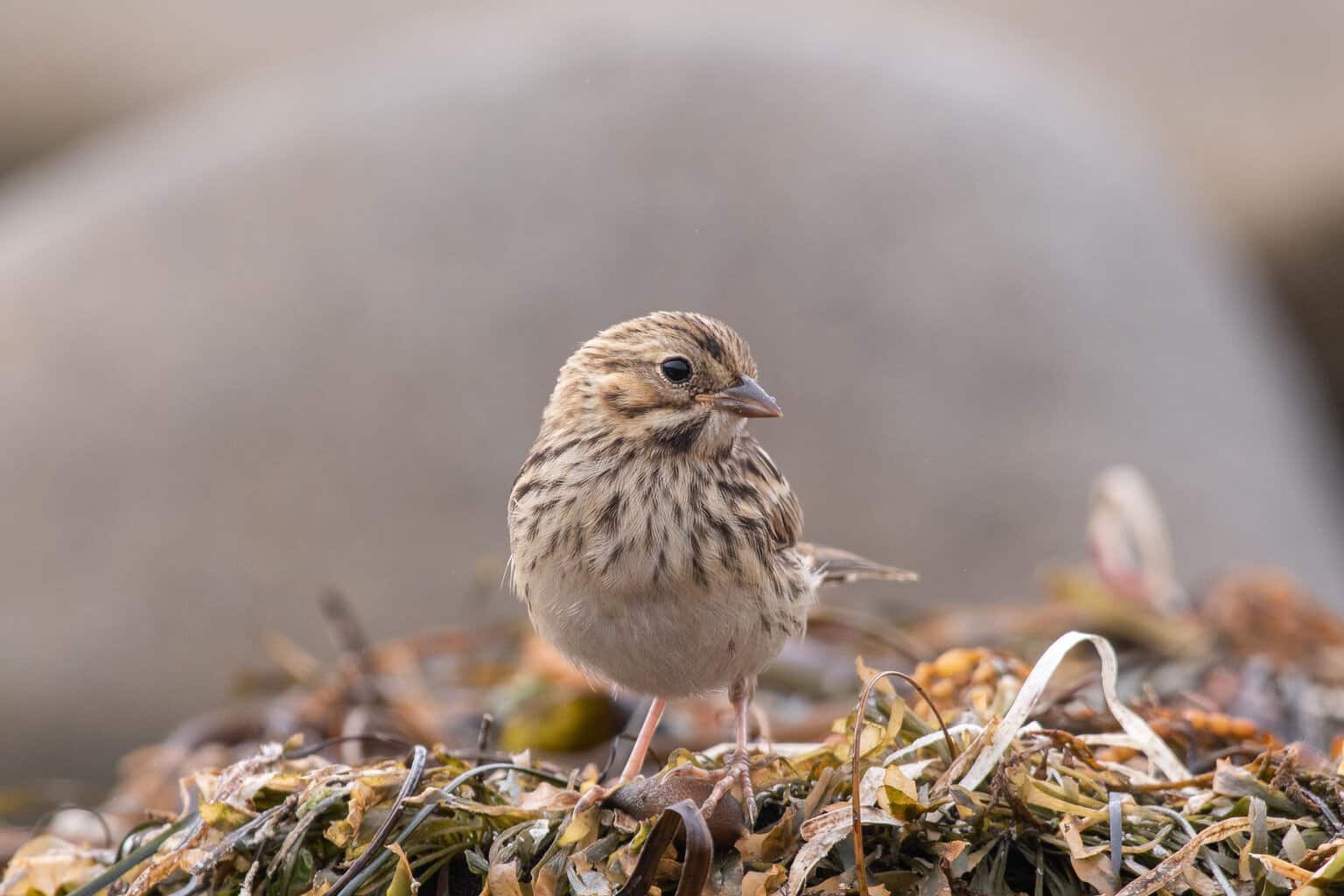
- Pooecetes gramineus
- Length: 5.1-6.3 inches
- Weight: 0.7-1.0 ounces
- Wingspan: 9.4 inches
Vesper sparrows don’t have the signature yellow marking of the Savannah sparrow, but other than that and the vesper sparrow’s thicker white eyering and white outside tail feathers, they may slightly resemble one another in shape and markings, such as their brown streaks down the upper chest.
Except for northern Oklahoma, where they will more than likely just pass through during migration, the Sooner State provides winter habitat to vesper sparrows, which inhabit open areas like agricultural fields, pastures, and ditches, among other spots with minimal tree cover.
Grasshopper Sparrow
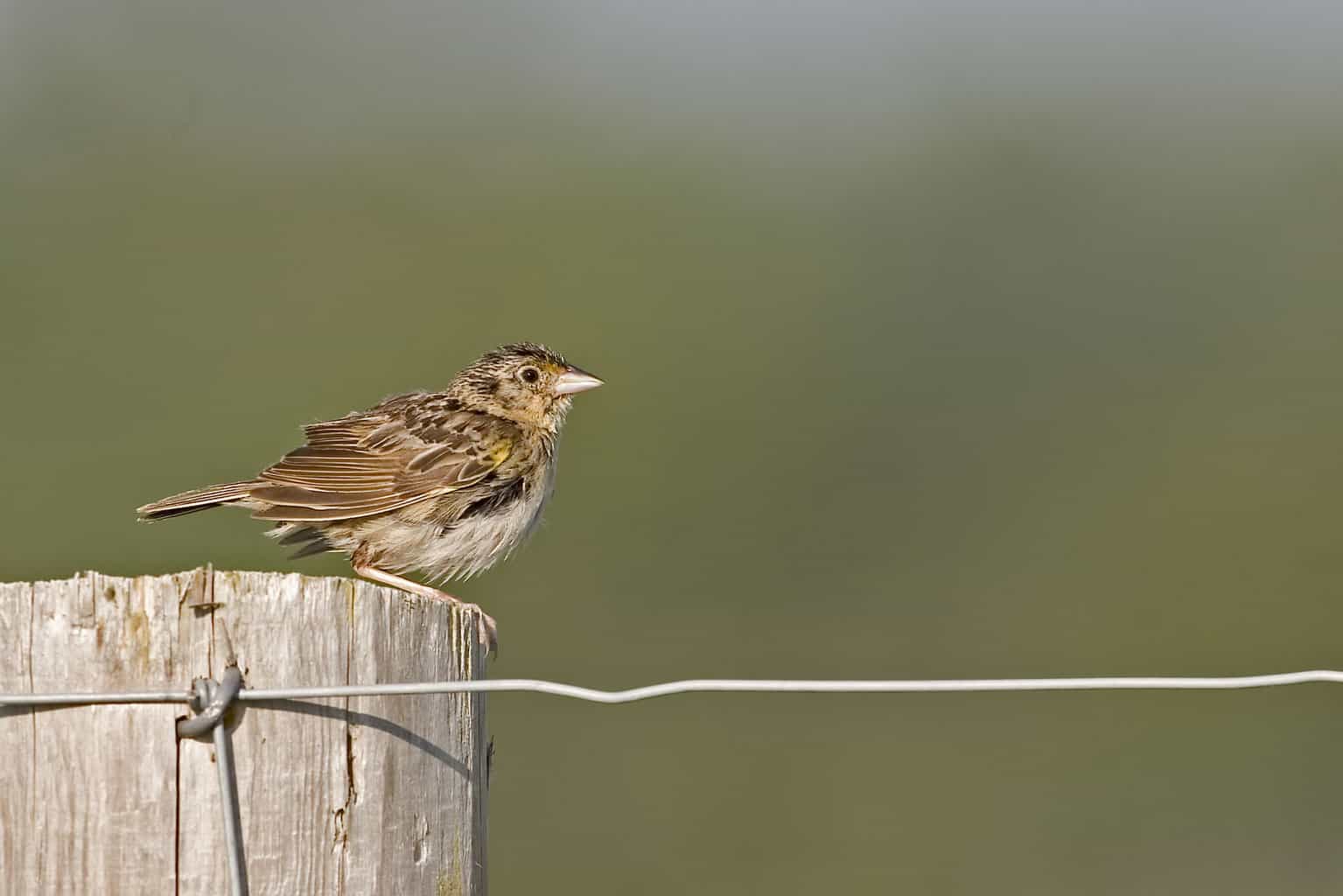
- Ammodramus savannarum
- Length: 4.3-4.5 inches
- Weight: 0.5-0.7 ounces
- Wingspan: 7.9 inches
Grasshopper sparrows have yellow facial markings, though they may be a little bit more inconspicuous than that of the Savannah sparrow, for example, instead blending more into the rest of the face.
They’re buffy, mostly unstreaked birds with flat heads. They have light markings on the upper chest and a relatively long bill for their minuscule size.
Not only are grasshoppers this bird’s top food choice, but they also sound kind of like a bug as well, firing off a song that’s typically several chipping notes before a longer “bzzzzzzz”, though they also have another song as well that’s a little more bird-like.
Here’s the more common buzzing sound:
Grasshopper sparrows are breeding residents of Oklahoma’s open areas.
Clay-colored Sparrow
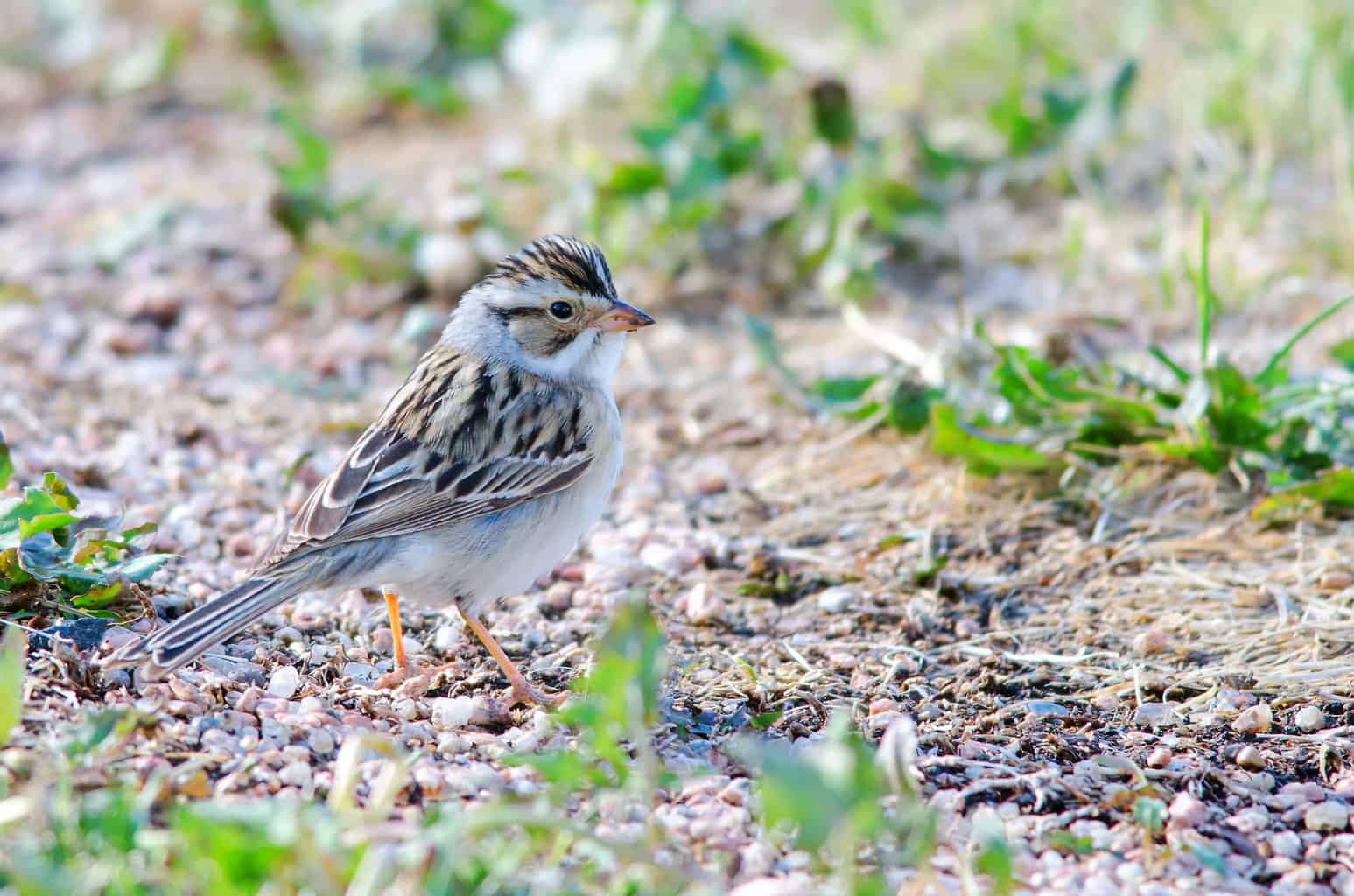
- Spizella pallida
- Length: 5.5 inches
- Weight: 0.42 ounces
- Wingspan: 7.5 inches
(Measurements via The Sibley Guide to Birds)
Clay-colored sparrows traverse America’s Heartland every year, moving between wintering grounds in Mexico and Texas and breeding grounds in Canada and the northern United States.
If you’re lucky enough to catch sight of one in Oklahoma, it’s most likely to be near the end of April or the start of May for their spring migration or sometime in October as they head south.
They have long, slim bodies with long tails and light tan, unstreaked undersides. Their faces are mostly tan with a couple of darker streaks over the top of the head and side of the face. They have a gray nape.
LeConte’s Sparrow

- Ammospiza leconteii
- Length: 4.7-5.1 inches
- Weight: 0.4-0.6 ounces
- Wingspan: 6.3-7.1 inches
LeConte’s sparrows follow a somewhat similar migration pattern to that of the clay-colored sparrow.
Each fall, they move from breeding areas in the Canadian provinces of Alberta, Saskatchewan, and Manitoba, as well as northern areas of states like Wisconsin, Minnesota, North Dakota, and Michigan, down through the Great Plains into the Gulf Coast states as well as bordering ones like Missouri, Arkansas, and Oklahoma.
These often yellowish sparrows have streaks along their sides and a buffy tan color from the bill down through the chest that lightens in color toward the belly.
They have a dark eyeline that pools into a larger spot near the back of the face.
Like many other sparrows, they’re going to be most commonly spotted in grasslands or marshy areas, though LeConte’s sparrows have a reputation for being a tough spot.
This is amplified by the fact that their populations have dropped considerably in the last 50 years, by about 2.6 percent per year from 1966 to 2015, according to the North American Breeding Bird Survey.
Henslow’s Sparrow
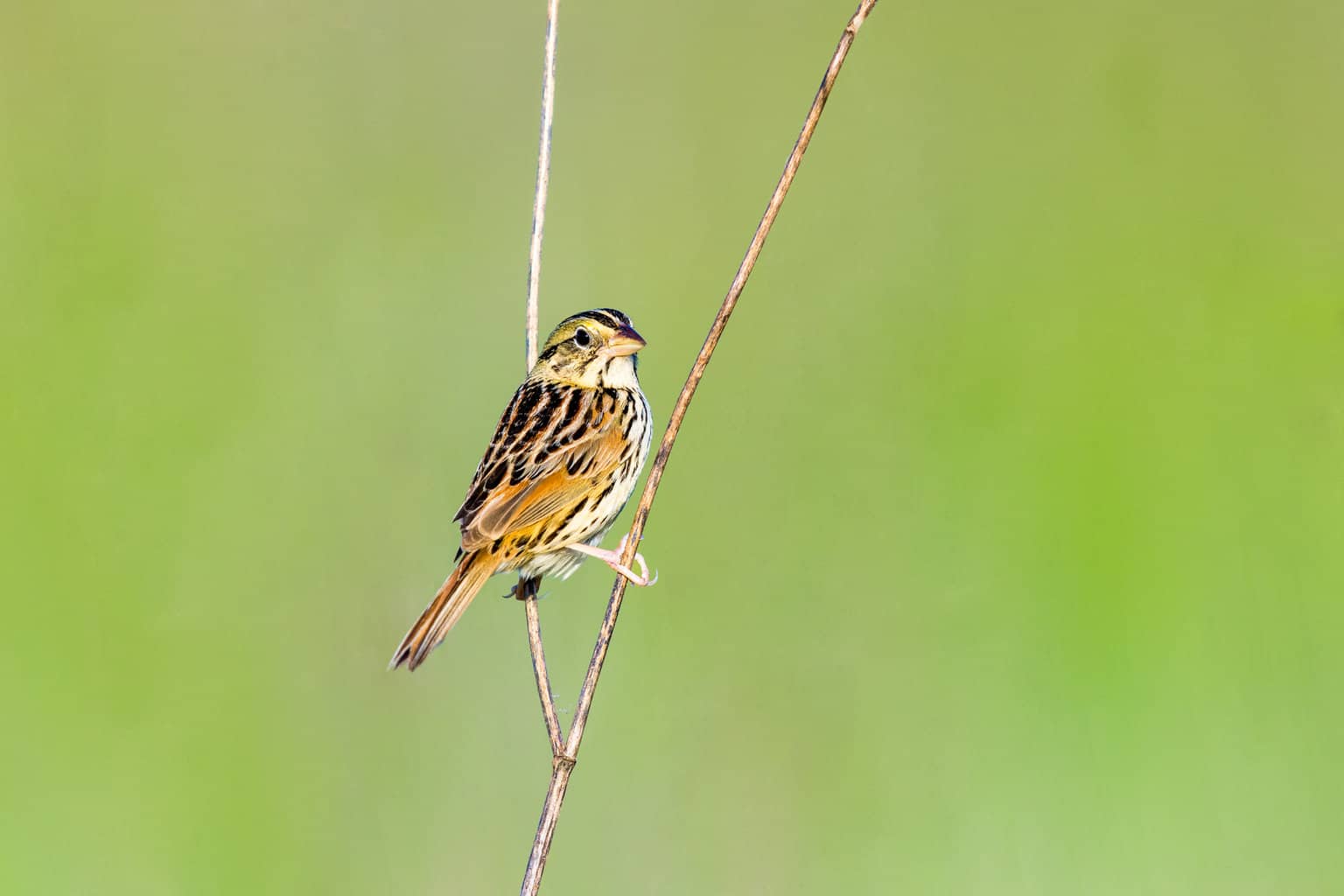
- Centronyx henslowii
- Length: 4.3-5.1 inches
- Weight: 0.4-0.5 ounces
- Wingspan: 6.3-7.9 inches
This is one sparrow whose range in Oklahoma is very limited. The Henslow’s sparrow’s range consists mostly of a belt through the eastern Midwest, just dipping into Washington and Osage counties.
As of July 2023, just five sightings of these birds ever reported by eBird users have come outside these two counties. Tallgrass Prairie Preserve in Osage County has produced sightings in 2021, 2022, and 2023.
Henslow’s sparrows vary from bird to bird in the yellowness of their faces. They have darker markings over the top of the head, in mustache markings, and behind the eye.
The top of their breasts are dotted in short streaks and they have rather large bills.
According to All About Birds, they have the shortest song of any North American songbird:
Nelson’s Sparrow
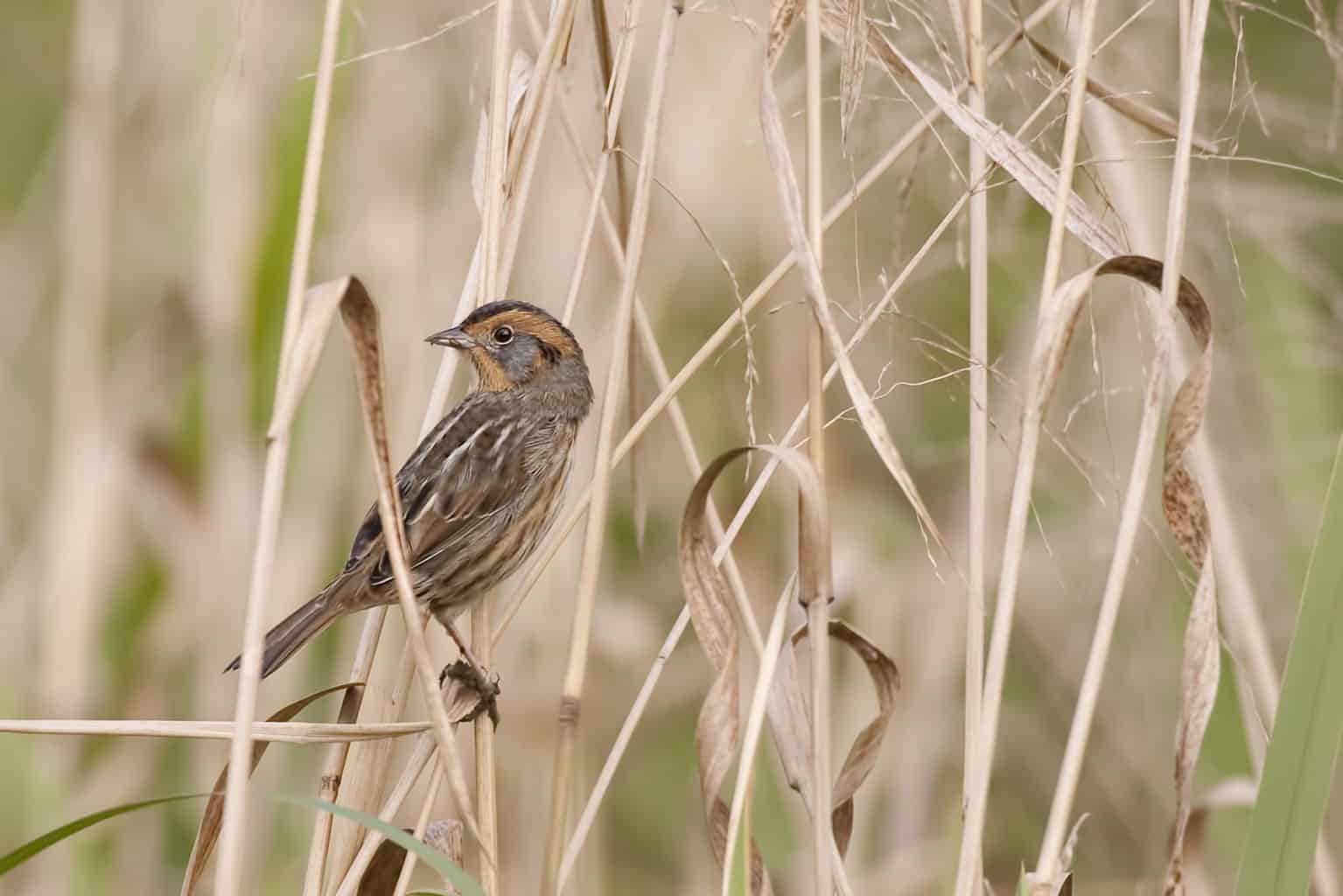
- Ammospiza nelsoni
- Length: 4.3-5.1 inches
- Weight: 0.6-0.7 ounces
- Wingspan: 6.5-7.9 inches
Sightings of Nelson’s sparrow, a temporary visitor on its annual migrations, are very rare in Oklahoma. In fact, eBird users have reported sightings of just six: two near Oklahoma City and four in the Osage/Washington County area.
Nelson’s sparrows have an orange-yellow tinge throughout their upper body that lightens near the belly. They have light streaking that doesn’t quite stand out as much as streaking on other, lighter-colored sparrows.
Lark Sparrow
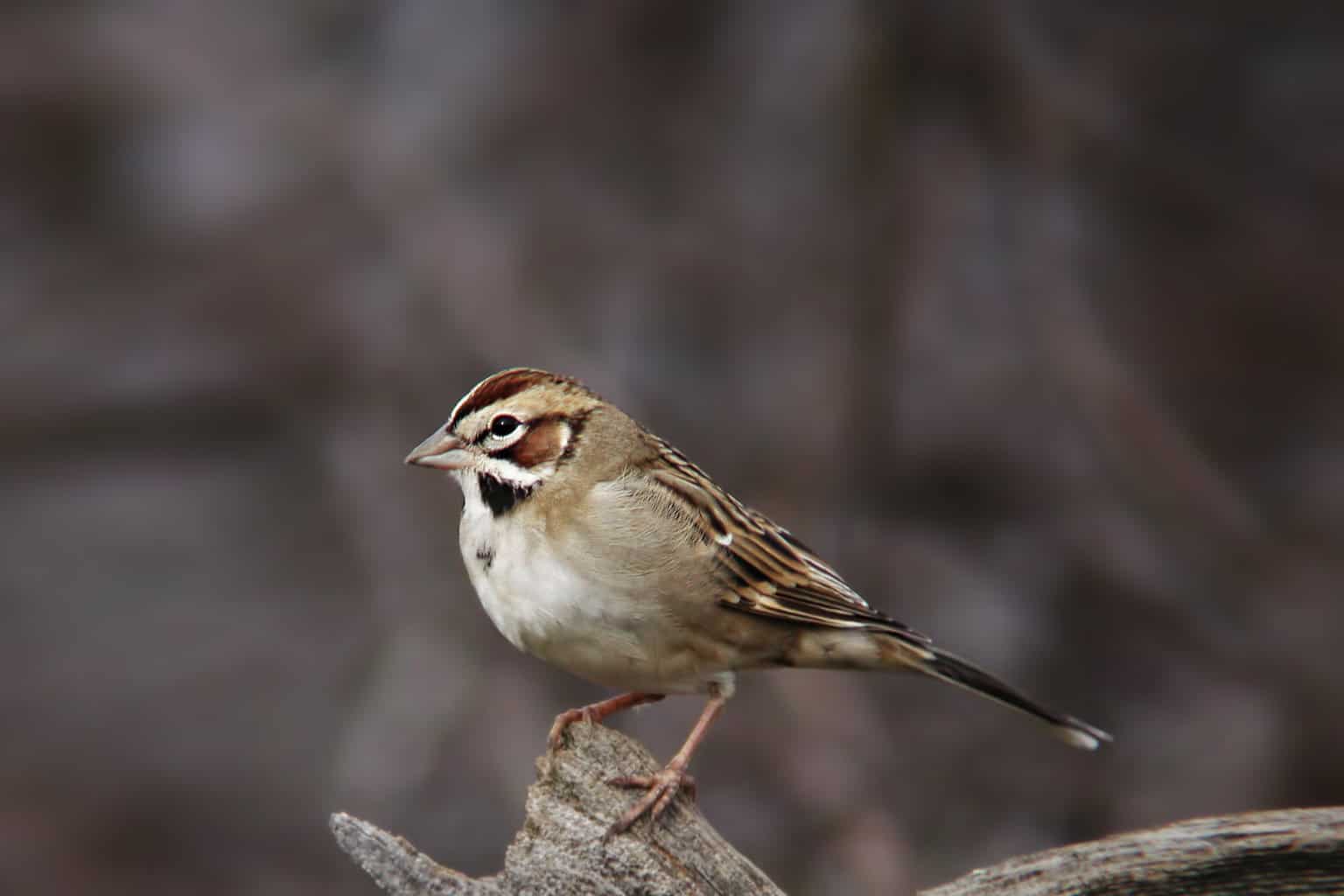
- Chondestes grammacus
- Length: 5.9-6.7 inches
- Weight: 0.8-1.2 ounces
- Wingspan: 11.0 inches
Lark sparrows, an Oklahoma breeder, feature crisp, distinctive markings that will help you instantly identify one out in the field, even from a distance.
They have black mustache marks and brown cheek and cap patches as well as a black circle centered right in the middle of the chest.
When viewed head-on, they may reveal unique outer tail feathers with white ends and darker black or gray patterned bases.
These fairly conspicuous sparrows occupy grasslands, agricultural fields, and other open areas of low vegetation.
Harris’s Sparrow
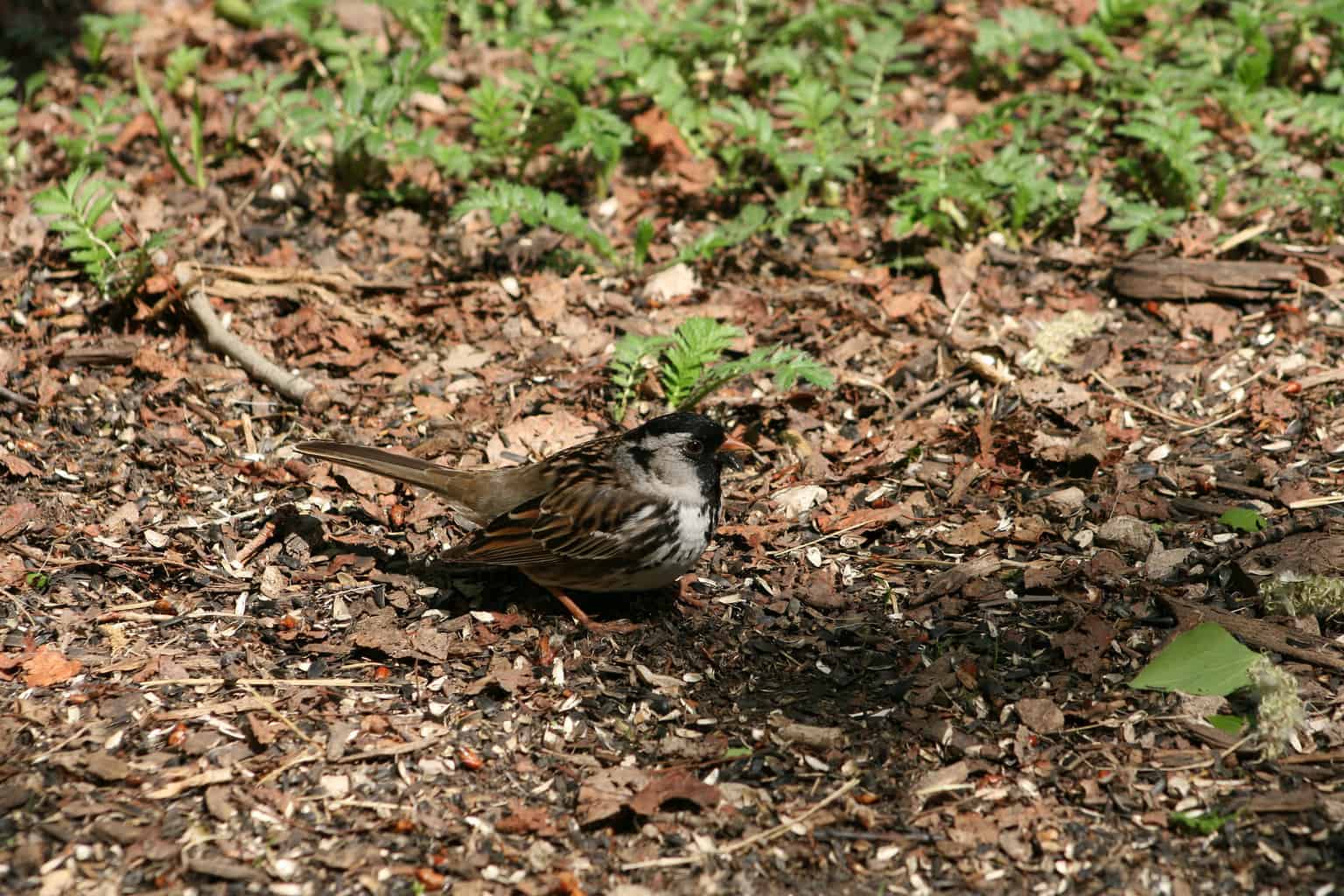
- Zonotrichia querula
- Length: 6.7-7.9 inches
- Weight: 0.9-1.7 ounces
- Wingspan: 10.6 inches
Oklahoma, Kansas, Nebraska, and Texas are prime wintering grounds for Harris’s sparrows – large, uniquely-colored sparrows that breed in a relatively small region of northern Canada.
Growing up to eight inches long with a wingspan surpassing 10 inches, this is among the largest sparrows on this list, which will help you to see its pretty black bib, face, and cap.
Both breeding and non-breeding adults have the look of a bird splashed with a tiny bucket of paint head-on, as the color stops at the side of the face. They have pinkish bills.
From fall through spring, Oklahomans can look for them in fields and streambanks, though you might feel like you’re seeing less and less of them as the years go on. That’s because according to Partners in Flight, their population has declined 63 percent since 1970.
Partners in Flight cites climate change’s impacts across their breeding range, deforestation, and a loss of agricultural habitat in their winter range as threats.
White-crowned Sparrow
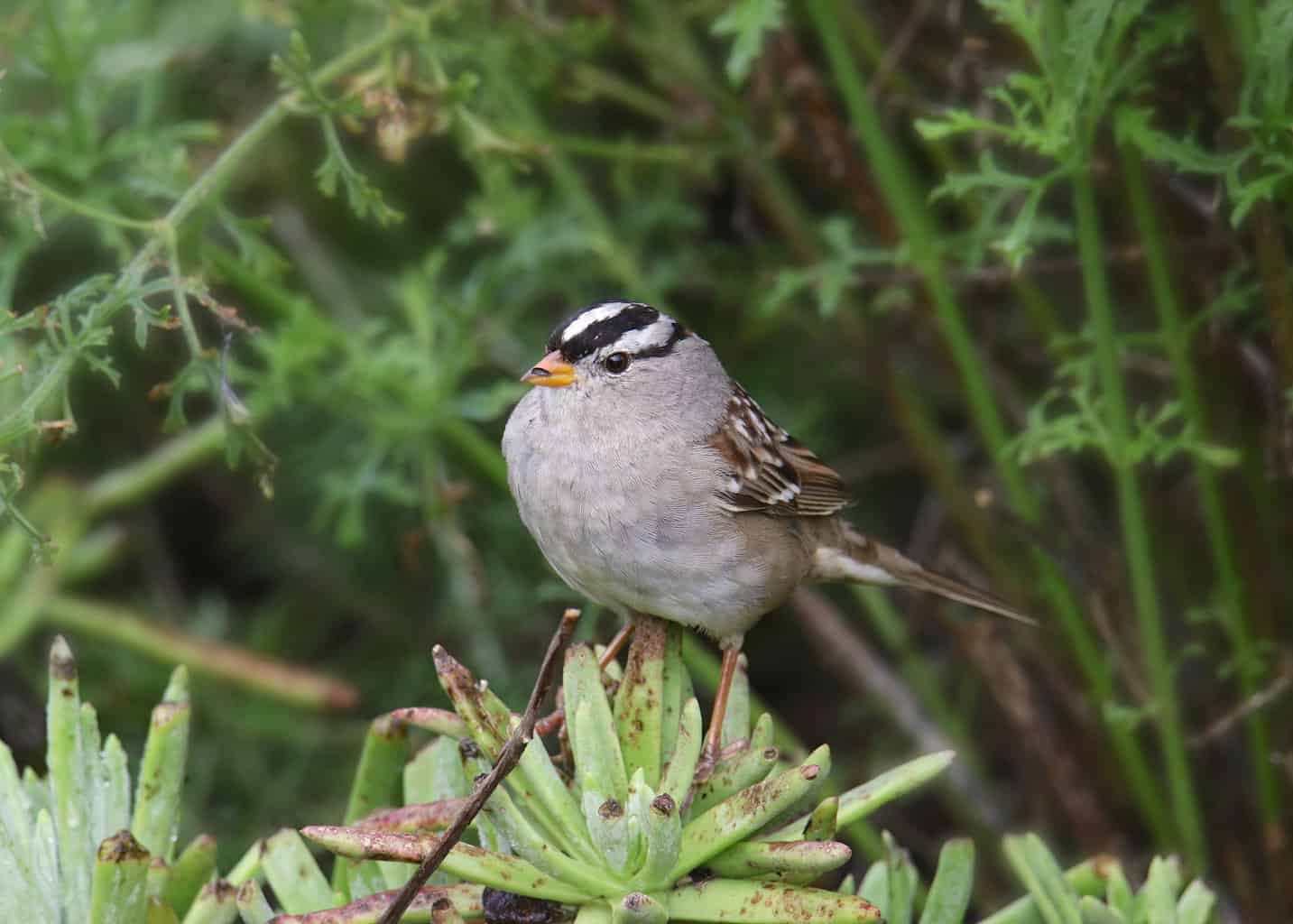
- Zonotrichia leucophrys
- Length: 5.9-6.3 inches
- Weight: 0.9-1.0 ounces
- Wingspan: 8.3-9.4 inches
Another northern breeder, white-crowned sparrows are a winter delight for much of the Lower 48, including Oklahoma. They’re common visitors to backyards, feeders, and parks, among other areas.
Their signature look is their crown of alternating white and black that starts at a black eyeline. The lower half of the face is gray, along with the bird’s underside.
According to the Oklahoma DWC, they’re more common in western and central Oklahoma, but they can be found across the state from early October to early May.
If you’re looking to feed them in your yard, the DWC suggests millet, milo, and black oil sunflower seeds.
White-throated Sparrow
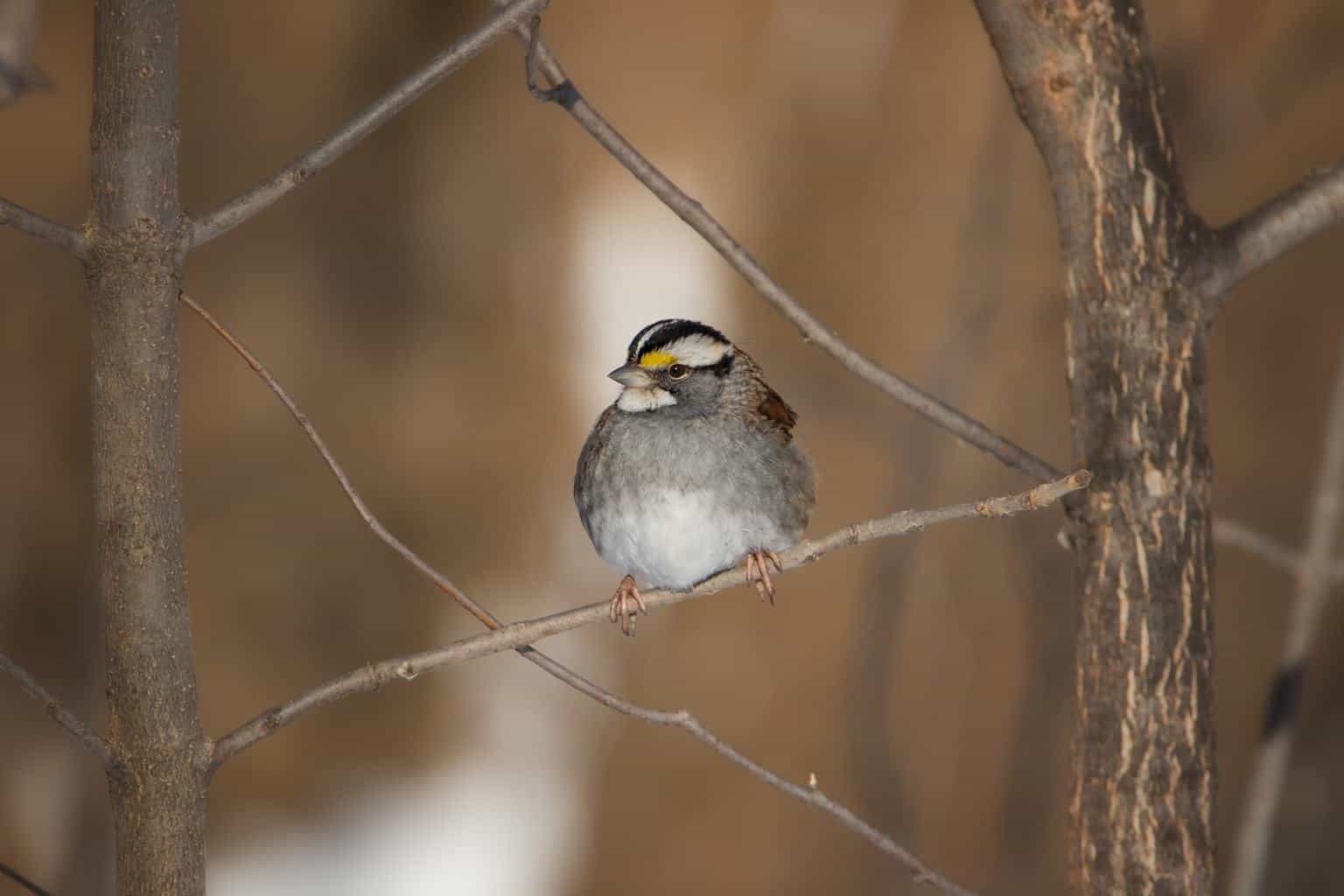
- Zonotrichia albicollis
- Length: 6.3-7.1 inches
- Weight: 0.8-1.1 ounces
- Wingspan: 7.9-9.1 inches
We move from the white-crowned sparrow to the aptly named white-throated sparrow, yet another wintering resident of the Sooner State, though they tend to be rarer in the western reaches of the state.
White-throated sparrows have a white and black cap with a yellow eyebrow marking and a fluffy-looking patch of white just under the bill.
The Oklahoma DWC lists woodlands, streamsides, and forests as the top habitat types for white-throated sparrows, noting that they will visit residential areas with enough trees or other cover.
Black-throated Sparrow
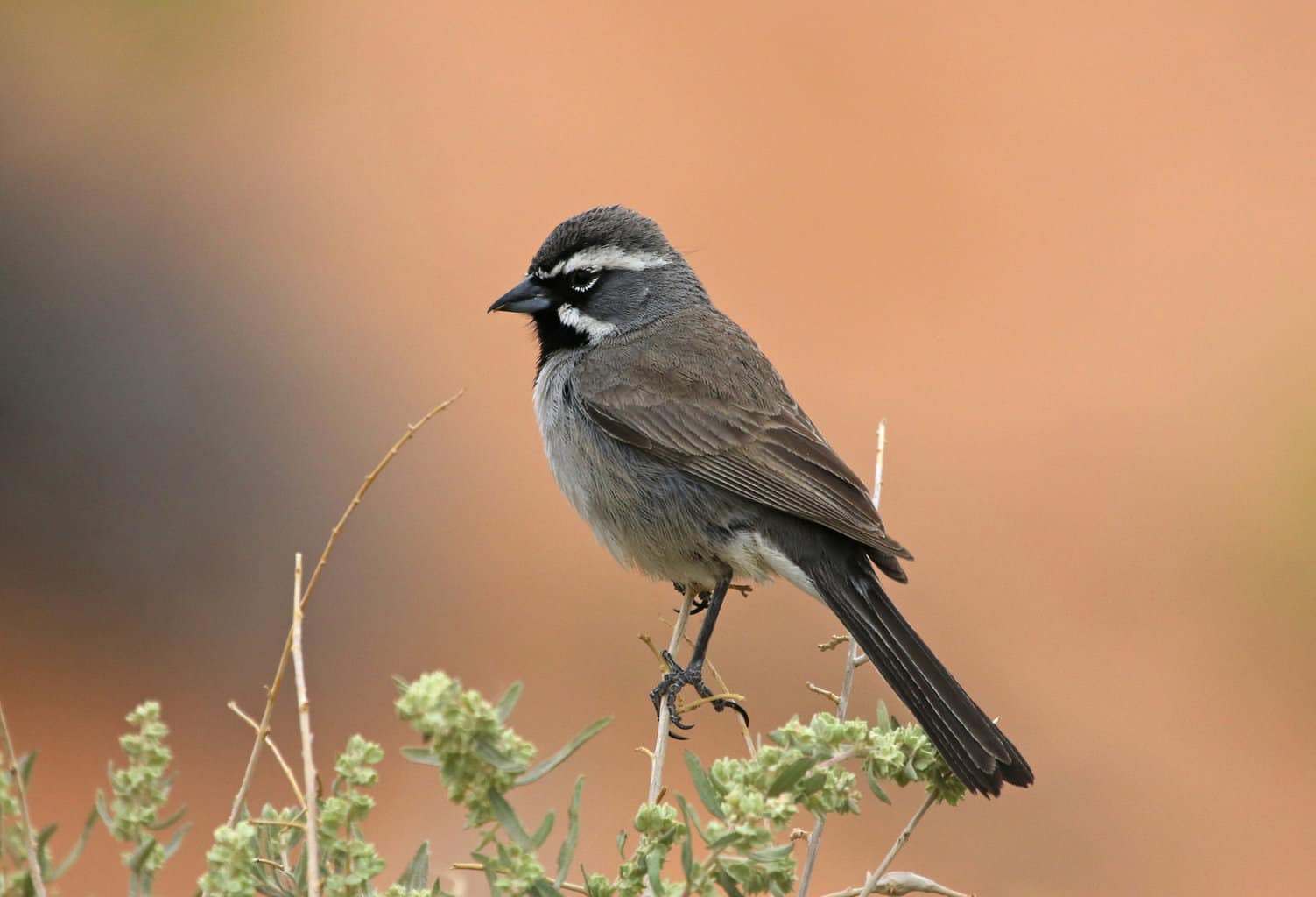
- Amphispiza bilineata
- Length: 4.7-5.5 inches
- Weight: 0.4-0.5 ounces
- Wingspan: 7.7 inches
To see a black-throated sparrow in Oklahoma, you’ll probably have to travel to the very end of the Panhandle to areas around Kenton.
The hottest black-throated sparrow location in the state is undoubtedly Easter Pageant in Cimarron County, where sightings have been reported each year from 2013 to 2023 by eBird users.
They have a long black patch that flows down like a long beard, covering their upper chest, throat, and facial area below the bill, bordered on the top by a white stripe on either side of the bill, with another thick white stripe above the eye.
Cassin’s Sparrow
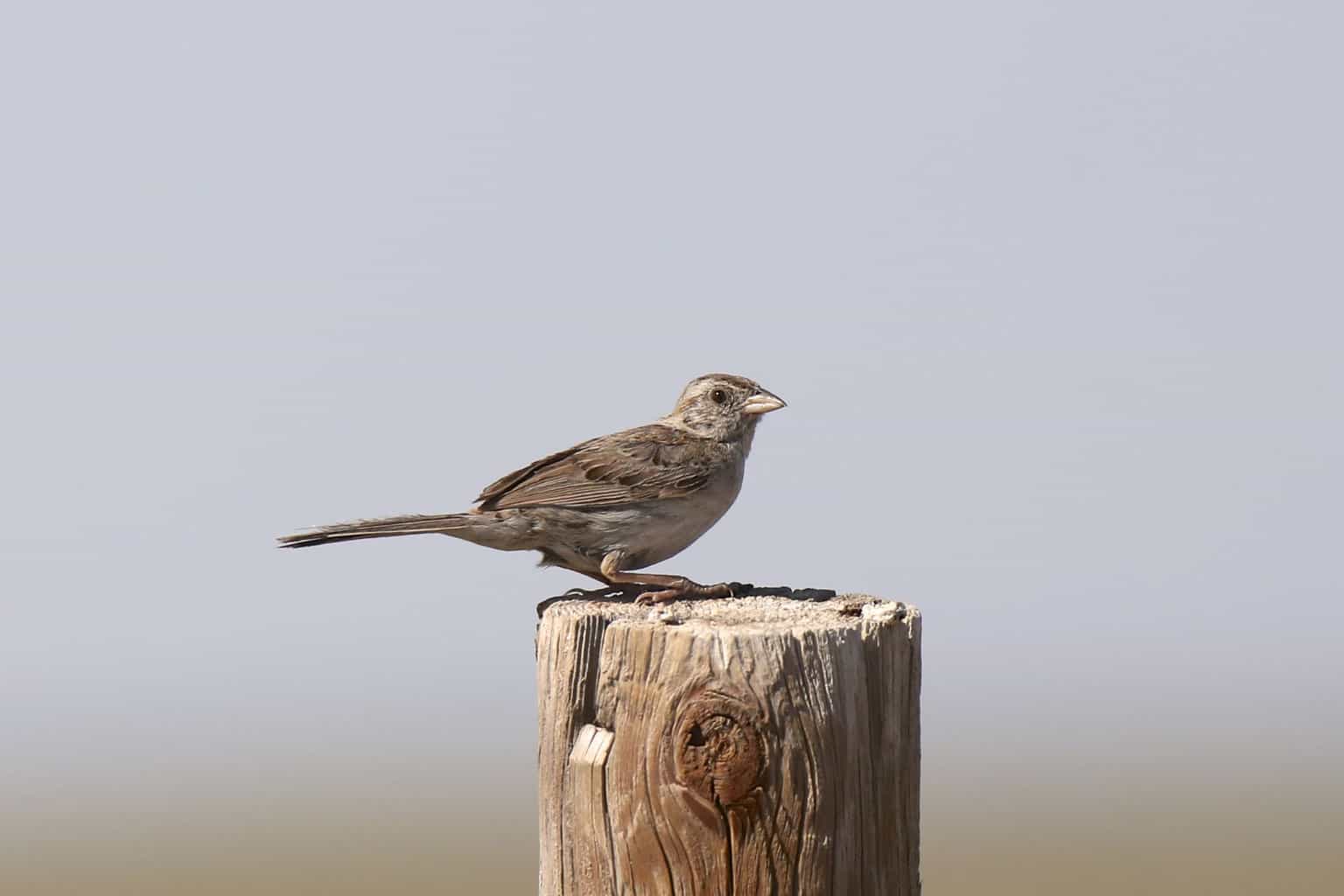
- Peucaea cassinii
- Length: 5.1-5.9 inches
- Weight: 0.6-0.7 ounces
- Wingspan: 7.9 inches
Cassin’s sparrows occupy dry areas of the Southwest and parts of the Great Plains, including Western Oklahoma, where they spend the breeding season.
They don’t have the instantly identifiable markings like the last couple of birds on this list, with a relatively unstreaked underside and a light line behind the eye. Some will be a reddish-brown color.
Listening out for Cassin’s sparrow’s simple song will help you in your identification:
Bachman’s Sparrow

- Peucaea aestivalis
- Length: 4.9-6.0 inches
- Weight: 0.6-0.8 ounces
- Wingspan: 7.2 inches
Similarly, Bachman’s sparrows aren’t the most easily identifiable birds either, but they’re not very common in Oklahoma either, with most sightings coming from the southeastern corner of the state.
If you’re on the hunt for one, consider Pushmataha Wildlife Management Area in Pushmataha County, where there have been multiple sightings reported by eBird users every year from 2019 to 2023.
They have a line behind the eye that’s darker than the rest of the face and a similarly colored top of the head. Their wings are a bronzed brown.
Next, continuing our theme of difficult-to-identify birds…
Brewer’s Sparrow
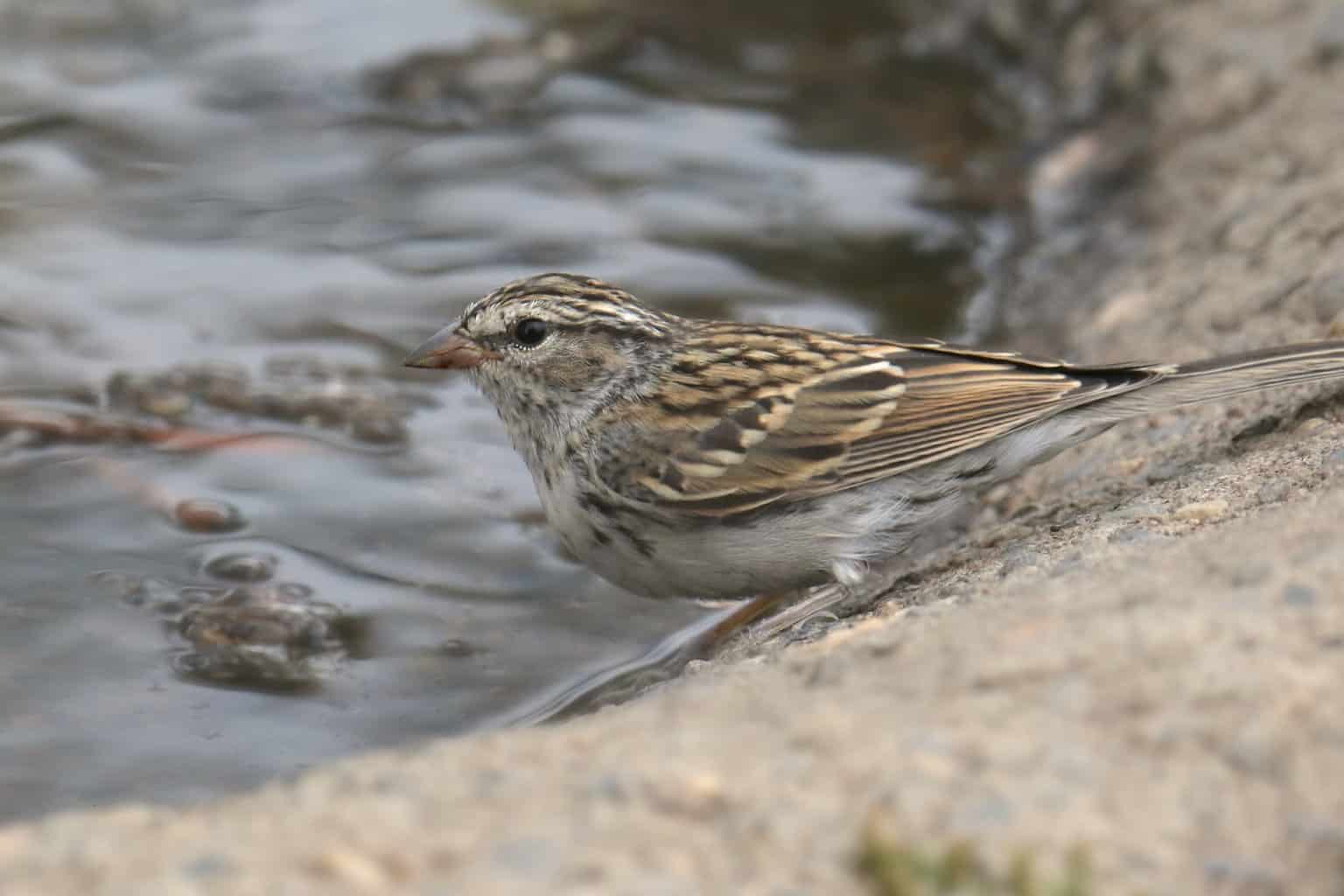
- Spizella breweri
- Length: 5.1-5.9 inches
- Weight: 0.4-0.5 ounces
- Wingspan: 7.1-7.9 inches
Brewer’s sparrow, dubbed the “bird without a field mark,” according to All About Birds, lacks a large white or black patch on the throat, a yellow mark above the eye, or a center spot near the chest like other more distinctive sparrows we touched on earlier in this list.
They have little markings near the mustache with two lighter streaks from the bill, one over the eye and the other near the mustache.
It’s not an ID that most Oklahomans will have to worry about very often, however. While the western edge of the Panhandle may see migrating Brewer’s sparrows briefly, they breed further west and north and winter further south than Oklahoma.
Rufous-crowned Sparrow
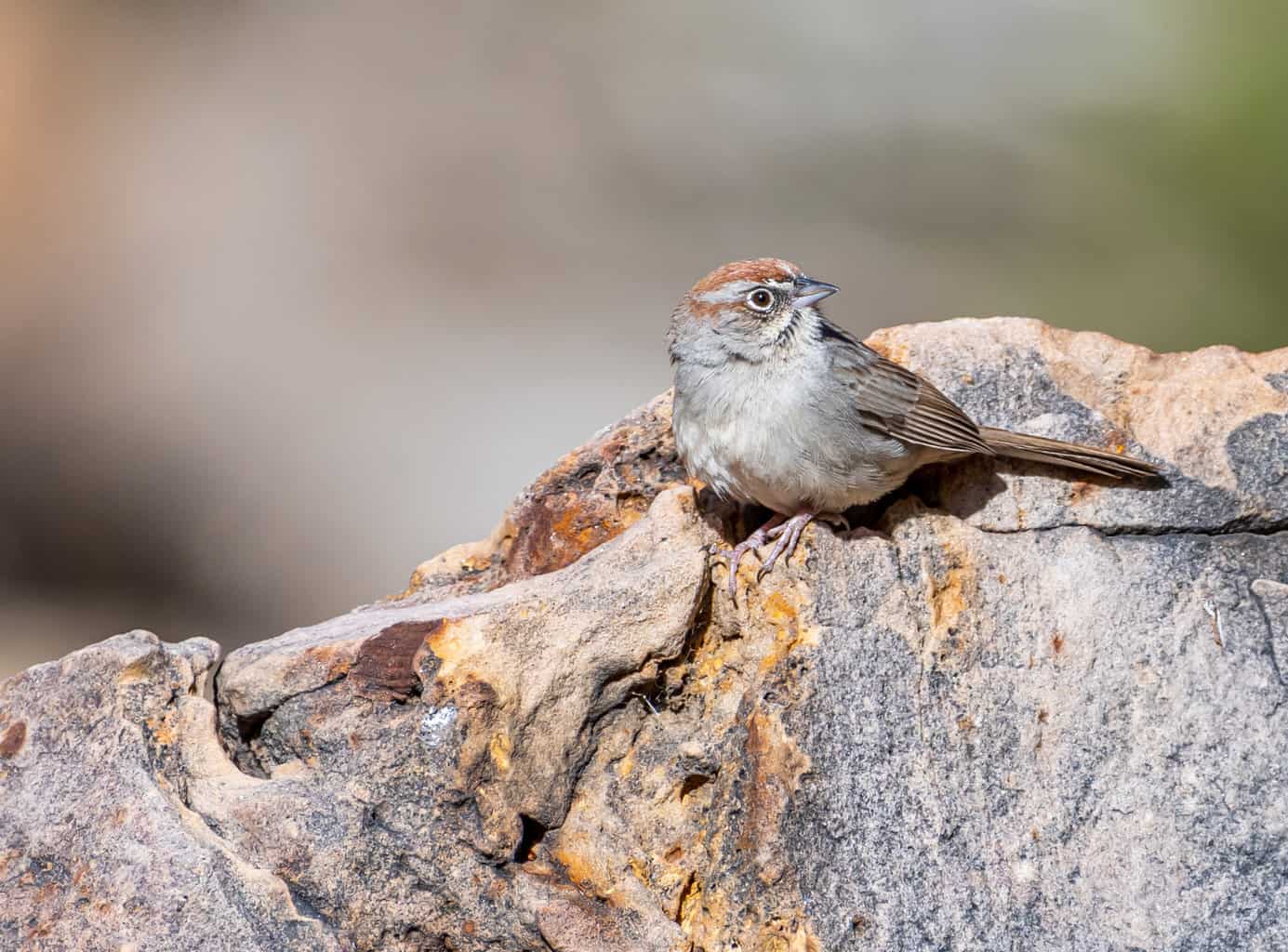
- Aimophila ruficeps
- Length: 5.9-6.3 inches
- Weight: 0.6-0.7 ounces
- Wingspan: 7.75 inches
Rufous-crowned sparrows have a rather sporadic range across the North American Southwest, with a range that weaves through parts of mostly California, Arizona, New Mexico, and Texas. Their year-round range also extends to Mexico, Utah, Nebraska, and Oklahoma.
They have rufous crowns and a rufous line behind the eye. They sport white and black mustache marks running lateral out from the bill and a white eyering.
They’re not often seen in flight, as according to All About Birds, the longest recorded flight of a rufous-crowned sparrow is about 540 feet. With that in mind, they do not migrate, spending the whole year in the dry, open areas of the Southwest.
Lark Bunting
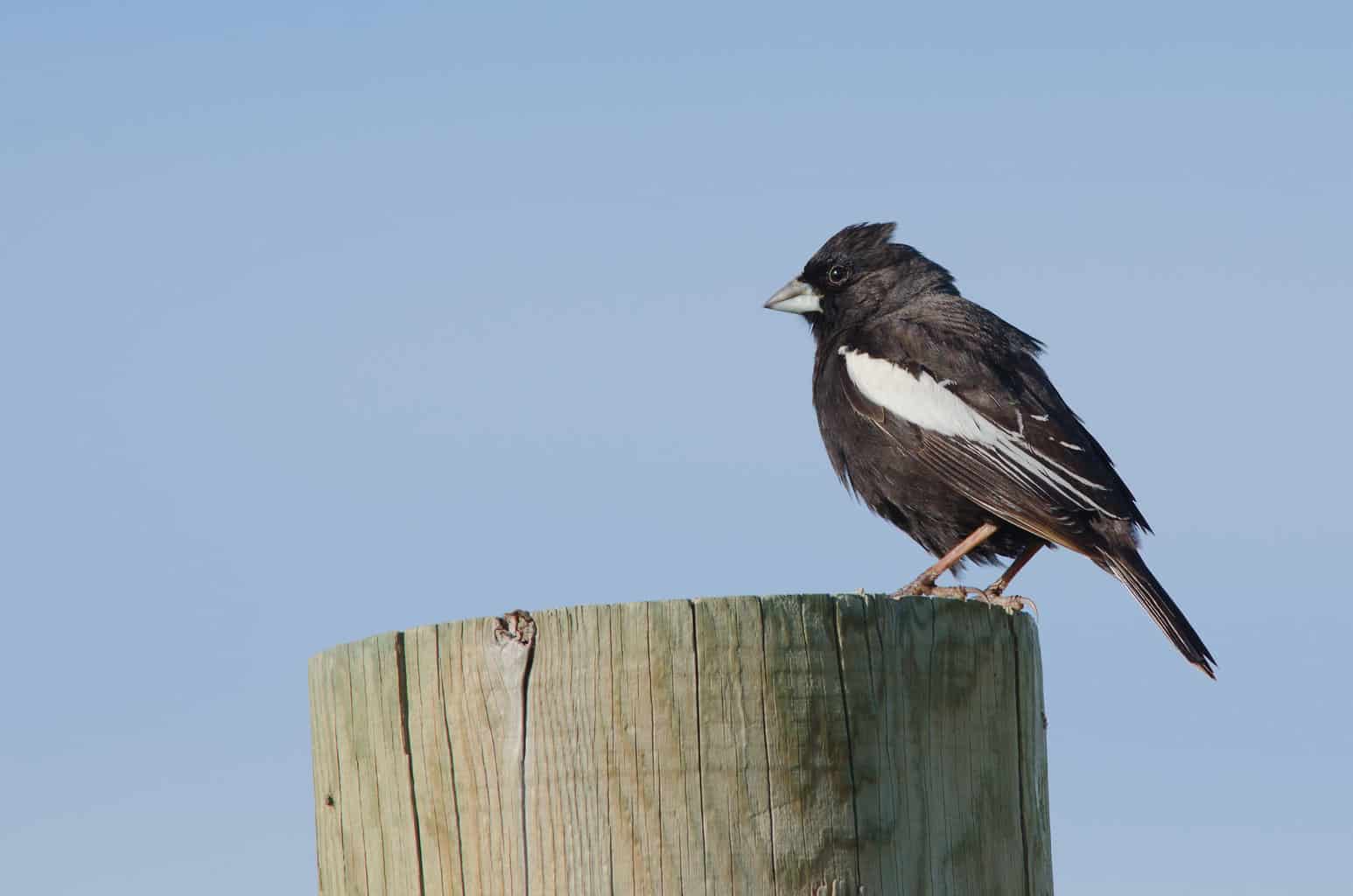
- Calamospiza melanocorys
- Length: 5.5-7.1 inches
- Weight: 1.3-1.5 ounces
- Wingspan: 9.8-11 inches
Lark bunting males and females differ greatly, an unusual feature for sparrows.
Breeding males aren’t likely to be confused with any other sparrow, with black and white plumage and thick gray bills. Their crisp colorations fade into non-breeding plumage, and females are mainly a streaky brown year-round. Females also have thick gray bills.
Eastern Oklahoma is less likely to see lark buntings, but they breed throughout the western half of the state and may even stay year-round.
Lark buntings breed in grasslands and agricultural fields and may group up in the winter.
Dark-eyed Junco

- Junco hyemalis
- Length: 5.5-6.3 inches
- Weight: 0.6-1.1 ounces
- Wingspan: 7.1-9.8 inches
Dark-eyed juncos are one of Oklahoma’s most common birds during the winter, according to the Oklahoma DWC, which states that they are the only bird within the borders with a dark upper body, white belly, yellowish-pinkish bill, and white outer tail feathers.
Juncos are common backyard visitors, where they are mostly seen hopping around below the feeder, picking up a variety of seeds that may have fallen. For many American backyard birders, their arrival marks the oncoming winter and their departure means warmer months are on the way.
Canyon Towhee
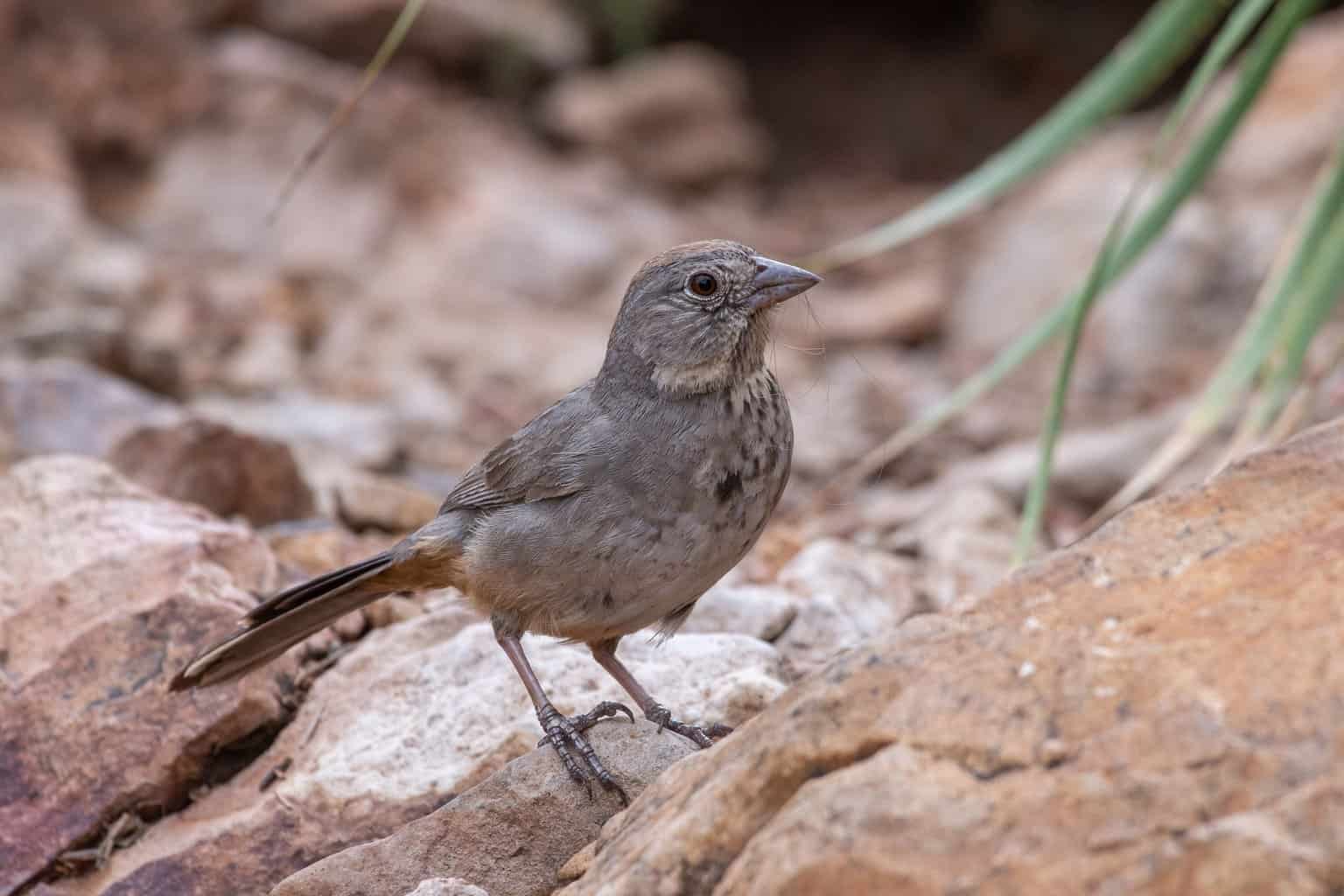
- Melozone fusca
- Length: 8.3-9.8 inches
- Weight: 1.3-1.9 ounces
- Wingspan: 11.5 inches
The first of four towhees on our list is an uncommon one in Oklahoma, with the western tip of the Panhandle offering the vast majority of sightings. Oklahoma isn’t really prime territory for any of the four towhees, though.
Canyon towhees are larger than most sparrows with varying tones of brown: grayish-brown over much of the body with lighter patches under the bill and a couple of red-brown markings near the rear.
Black Mesa State Park is one area that provides numerous sightings of canyon towhees all year, according to eBird users.
Green-tailed Towhee
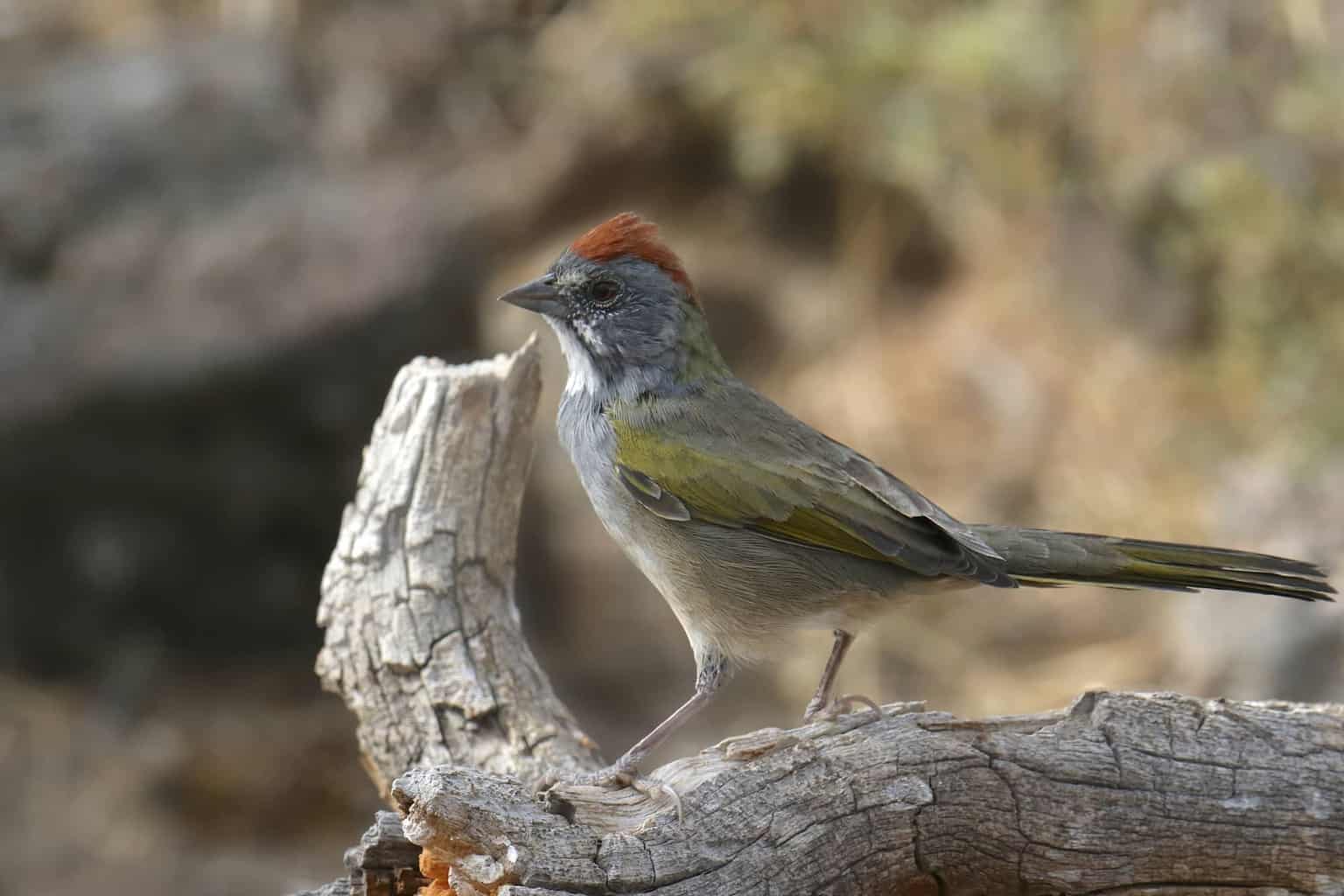
- Pipilo chlorurus
- Length: 7.1 inches
- Weight: 1 ounce
- Wingspan: 10 inches
(Measurements courtesy of the U.S. Forest Service)
For as concentrated as the canyon towhee’s range is in the state, sightings of the green-tailed towhee are even less frequent, as some birds’ migration path may just cut through the western Panhandle.
Green-tailed towhees are uniquely colored birds, with white chin patches, olive green wing edges and tail, and a bright reddish cap.
Spotted Towhee
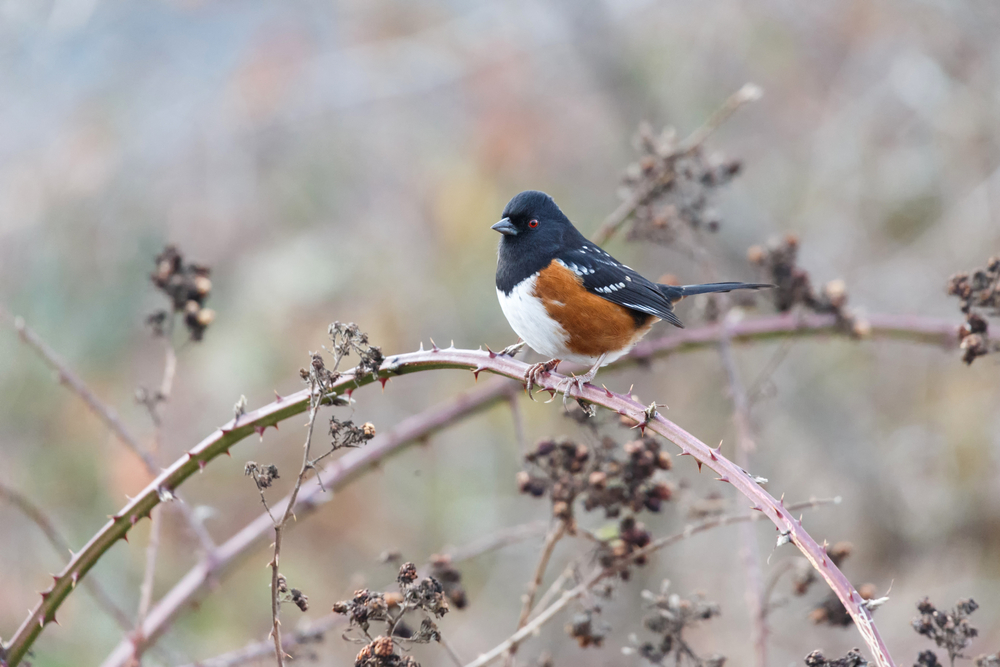
- Pipilo maculatus
- Length: 6.7-8.3 inches
- Weight: 1.2-1.7 ounces
- Wingspan: 11.0 inches
The United States is split into two fairly distinct ranges for its most common towhees: the spotted towhee in the west and the eastern towhee in the east. That kind of leaves Oklahoma in no man’s land.
Spotted towhees are a winter visitor to all but the eastern edge of the state. They stick to areas of relatively thick cover like trees and shrubs.
Males are mostly black with undersides of white and a rufous orange. They have red eyes and white spotting along the wings. Females have a very similar pattern with brown plumage instead of black.
Eastern Towhee

- Pipilo erythrophthalmus
- Length: 6.8-8.2 inches
- Weight: 1.1-1.8 ounces
- Wingspan: 7.9-11.0 inches
Eastern towhees and spotted towhees are similar in appearance. Male eastern towhees are mostly black with similar orange and white undersides as well as some white spotting on the wings, though they’re not as notable as that of the spotted towhee. Like their cousins, females are brown instead of black.
Eastern towhees may winter in the eastern half of Oklahoma, where you could see them on the ground and amongst low, dense vegetation.
More To Explore
While these 30 birds will make up the vast majority of sparrows seen in Oklahoma, birds can cover long distances and end up in unexpected places, so you never know what you might find on a birding adventure.
Wondering what other types of birds can be found in the Sooner State? Wild Bird Scoop has you covered with this list of some of the most popular birds in the state, as well as guides to Oklahoma’s woodpeckers, hawks, owls, hummingbirds, blackbirds, and ducks.

